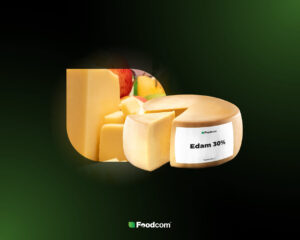- Summer sluggish demand and full warehouses are putting pressure on prices in most categories.
- Exports remain weak, especially in powders and fats, due to, among other things, the unfavourable EUR/USD exchange rate.
- Mozzarella is the only category holding up well thanks to seasonal demand from the catering industry.
- This is the last edition before the break – the market is waiting for a return to activity and clarity of direction in September.
Welcome Partners!
Welcome back to our newsletter!
The dairy markets are entering the summer stagnation without much resistance. Production in Europe has remained steady, but demand has fallen as buyers go on holiday. Most short-term needs were met at the start of the quarter, resulting in a drop in activity on spot markets and a general reduction in prices. Export competitiveness continues to suffer due to the unfavourable EUR/USD exchange rate and stocks are starting to rise in several key product categories. There is no panic, but there is no urgency either – the market seems sluggish and lacking in interest.
This is our last report before the August break and forecasts remain stable at best. Barring some major triggering factor – extreme weather, unexpected political events or currency shocks – August is likely to be a month of stagnation. The real action will begin in September, with the industry returning, Q4 planning starting and the Oceania dairy season. For now, manage exposure, protect margins and avoid following weak demand. The next full update will come in early September.
Scroll down for detailed market data and forecasts.
Milk powder
The European SMP market is still stuck. Despite a year-on-year increase in production, there is no urgency on the demand side to support prices. Export channels are performing poorly, burdened by currency pressure and fluctuating purchases. Food grade SMP is trading in a narrow price range of 2300-2380 EUR/MT, but sentiment remains weak. There is little activity in the spot market and the lack of tenders for large volumes leaves sellers on the defensive.
The feed grade SMP is following a similar trajectory. Inventories are starting to rise at key production centres and, unless the dynamics change, the market could weaken further in August. Buyers have demand covered, traders remain calm and there is little reason to take long positions until volatility returns.
WMP prices continue to hold at a premium that seems increasingly disconnected from production costs. With production costs pointing closer to 4000 EUR/MT, current spot prices of around 4250 EUR/MT are difficult to justify. Consumption remains uneven and industrial users – especially in the confectionery industry – are not seeking to increase volumes. Unless end demand improves significantly, WMP has limited scope to maintain its position in the coming weeks.
Prediction:
The balance of risk remains tilted towards the downside. SMP lacks a demand catalyst and supply-side discipline has yet to take effect. Without stronger exports or a significant correction in milk supply, prices are likely to weaken further. Meanwhile, WMP appears vulnerable to a correction if premiums do not hold up by the end of Q3. The powder sector remains volatile and without clear signals, the easiest solution will be for prices to fall further.
Cheese
The European cheese market remains strongly divided. On the one hand, mozzarella continues to benefit from strong seasonal demand, particularly in Southern Europe where catering channels absorb significant volumes. Spot and futures contracts remain above 4450 EUR/MT, supported by limited availability and steady offtake.
In contrast, the situation for Gouda, Edam and mild Cheddar cheeses is much less optimistic. Stocks remain high, especially in Northern Europe and the UK, and sellers are increasingly focused on selling off stock. Spot bids for Gouda and Edam cheeses are falling to 4100-4250 EUR/MT and buyers are reluctant to build up stocks in a market lacking clear direction. Mild cheddar prices have fallen slightly but remain relatively stable at 4550-4600 EUR/MT. Meanwhile, mature cheddar maintains a premium through Q4 futures.
Producers face a difficult choice: carry the product into an uncertain autumn or increase volumes now and protect margins. With no growth opportunities in the short term, many are opting for aggressive forward sales, especially producers exporting products that are sensitive to the economy. Exports have improved somewhat, but remain uneven. The US market has gained momentum, but logistical difficulties and currency pressures continue to limit the competitiveness of European manufacturers abroad.
Predictions:
The cheese market is at a crossroads. Mozzarella seems supported at the moment, but seasonal momentum will weaken in early September. For other varieties, the lack of urgent demand and large stocks suggest continued pressure. Fourth-quarter futures have already started to weaken, indicating limited confidence in an end-of-year rebound. Unless there is a change in consumption patterns or supply-side intervention, the cheese market is likely to remain under pressure in the next quarter as well.
Fats
Butter prices in Europe are starting to fall on the back of pessimistic forecasts. Production remains high and imports have increased slightly in recent months, a stark contrast to the shortages that prevailed at the beginning of the year. Meanwhile, exports have lost momentum and EU-origin butter is struggling to gain traction on world markets. As a result, stocks are rising and spot prices are starting to feel the pressure.
Buyers remain active near the 7000 EUR/MT level, but sentiment is noticeably softer than it was just a few weeks ago. Cream prices, which used to approach 8900 EUR/MT, have corrected sharply and now remain well below 8000 EUR/MT, which has somewhat dampened the rise in butter prices. The recent return of cooler weather in central and western Europe has helped stabilise milk flows, reducing the urgency of purchases.
Non-fat milk fat (AMF) prices remain more stable for the time being, staying within a narrow range. Demand from industrial users and exporters has not collapsed, but is not increasing either. Sellers are carefully managing volumes to avoid unnecessary price falls. Nevertheless, sentiment is cautious and could deteriorate further if butter prices continue to fall.
Prediction:
Butter is under pressure and there are few signs that this trend will be reversed any time soon. Stocks are rising, exports are disappointing and cream prices are falling. Unless there is an unexpected increase in demand or a significant drop in milk supply, prices are likely to continue to fall in August. AMF may hold its position for a little longer, but without external support there is a risk of falling prices in the fourth quarter as well.
Fluids
Cream prices have fallen slightly in recent weeks, particularly in Central Europe, where cooler weather has encouraged stable milk flows and eased pressure on the spot market. Western Europe remains slightly more stable, but the general mood has become more cautious. Buyers are approaching the market with restraint, fearing a further fall in prices after peaking in early summer.
The correction in cream prices is also eroding margins across the value chain. Dairy fat no longer has the same pricing power as it did just a few weeks ago, and processors are starting to reassess their product mix strategies at the end of the third quarter.
SMC prices have increased slightly, especially for protein products from Germany, where they have reached 2200 EUR/MT. Concentrate of French origin is slightly cheaper, but availability is significantly limited. The supply of raw milk remains limited in some regions and processors continue to prioritise protein-rich raw materials to maintain value – a difficult task that is further hampered by weak prices in the cheese and powder segments.
Prediction:
Liquid prices are entering a more volatile phase. Cream may see a further decline if milk supplies remain stable and downstream demand does not increase. For SMC, the potential for growth appears limited – availability is tight, as are processor margins. Unless there is an increase in cheese or whey prices, there is little room for growth. Risks in both directions are to be expected in August and spot market activity is likely to remain tactical and reactive.
Whey powder
The European whey powder (SWP) marketcontinues to fail to impress. There is little activity on the spot market and the price range reflects a market situation characterised by oversupply. The price of sweet whey for food use is 980-1030 EUR/MT and whey for feed use is around 800-850 EUR/MT. There is no trend in either direction – buyers are assured of supply and sellers are finding it difficult to create pressure without squeezing margins.
Demand in Asia continues to disappoint, especially in feed applications, and interest in the European market is transactional rather than strategic. Producers are increasingly diverting volumes to higher-margin protein derivatives, further reducing liquidity in the basic powder market.
WPC 80 prices are holding steady, with European bids around 12 000 EUR/MT. Most volumes for Q3 are already booked and producers are slowly raising offers for the end of Q3 and beginning of Q4. US exports are increasing, but EU-origin products continue to face resistance in price-sensitive markets.
WPI prices have seen a slight recovery, with European prices fluctuating in the 19 500-20 000 EUR/MT range. Supply concerns are beginning to strengthen sentiment, particularly for year-end positions, as production constraints limit the availability of ultrafine streams.
Whey permeate remains a weak link. The price of the European product is hovering around 800 EUR/MT, while the US material is leading at the lowest end of the global market at 480-500 EUR/MT. Weak demand from Asia and the Middle East continues to hold back value growth. Buyers know there is no shortage and are pricing accordingly.
Prediction:
Whey markets remain structurally weak at the base level, with isolated stability in high-protein fractions. Without stronger Asian demand or significant European production cuts, food and feed grade SWP prices are likely to remain flat or weak. WPC and WPI currently provide better margin protection, but even these segments could come under pressure if global demand does not pick up by early Q4. In the case of permeate, there is no reason for optimism – the bottom may not be far away, but the peak is not in sight.
What’s new?
New Zealand
The dairy industry in New Zealand is benefiting significantly from a surge in global butter prices, driven by strong international demand and limited global supply. These price dynamics translate into higher returns for farmers and increased export earnings, reinforcing the sector’s key role in the domestic economy. While domestic consumers may feel pressure from retail price increases, the overall impact on agricultural investment and regional economic activity remains strongly positive, putting the dairy industry in a good position for further growth and resilience in a competitive global market.
USA
The latest trade report sharply criticises the US for taking the moral high ground in condemning Canada’s protectionism in the dairy sector, while they themselves use almost identical policy tools in the domestic market. The study highlighted that the interests of the US dairy sector are based on tariff quotas, import restrictions and revenue pooling mechanisms similar to those used by Canada. Despite US complaints about 200-400% Canadian tariffs on US dairy exports. The US position does not build credibility and undermines confidence in the global trade discourse. The report argues that Washington’s objectivity is compromised because the mechanisms it condemns are part of its own regulatory regime.
Australia
The Australian dairy sector is making significant progress towards carbon neutrality, incorporating emissions reductions into the entire milk production cycle, from feed and herd management to energy-efficient farms and advanced waste management systems. Farmers are implementing innovations such as optimised feed use, precision manure management, renewable energy installations and efficiency-enhancing technologies that not only reduce greenhouse gas emissions, but also increase farm resilience and profitability. This industry-wide commitment is driven by consumer demand for sustainably produced dairy products, regulatory dynamics and strategic partnerships with research and technology providers. As one of the world’s leading dairy exporters, Australia is setting a global standard for environmental transformation, demonstrating that environmental concerns can coexist harmoniously with large-scale dairy production.
![Summer dispersal and inventory pressure – the dairy market is waiting for a boost [278th Edition of DAIRY Newsletter] Summer dispersal and inventory pressure – the dairy market is waiting for a boost [278th Edition of DAIRY Newsletter]](https://foodcom.pl/wp-content/uploads/2023/08/Foodcom_SA_Whats_up_Newsletter_Dairy-1520x760.jpg)






